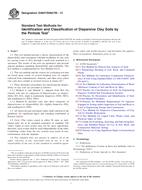Potrebujeme váš súhlas na využitie jednotlivých dát, aby sa vám okrem iného mohli ukazovať informácie týkajúce sa vašich záujmov. Súhlas udelíte kliknutím na tlačidlo „OK“.
ASTM D4647/D4647M-13
Standard Test Methods for Identification and Classification of Dispersive Clay Soils by the Pinhole Test
Automaticky preložený názov:
Štandardné skúšobné metódy pre identifikáciu a klasifikáciu disperzné ílovitých pôdach od dierky testu
NORMA vydaná dňa 1.1.2013
Informácie o norme:
Označenie normy: ASTM D4647/D4647M-13
Poznámka: NEPLATNÁ
Dátum vydania normy: 1.1.2013
Kód tovaru: NS-28024
Počet strán: 11
Približná hmotnosť: 33 g (0.07 libier)
Krajina: Americká technická norma
Kategória: Technické normy ASTM
Kategórie - podobné normy:
Zemní práce. Hloubicí práce. Budování základů. Podzemní práce
Anotácia textu normy ASTM D4647/D4647M-13 :
Keywords:
clay, clay (dispersive), collodial erodibility, dispersibility, dispersivity, dispersion, dispersive clays, erosion, pinhole, soils, ICS Number Code 93.020 (Earth works. Excavations. Foundation construction. Underground works)
Doplňujúce informácie
| Significance and Use | ||||||||||||||||||||||
|
5.1 The pinhole test provides one method of identifying the dispersive characteristics of clay soils that are to be or have been used in earth construction. The piping failures of a number of homogeneous earth dams, erosion along channel or canal banks, and rainfall erosion of earthen structures have been attributed to the colloidal erosion along cracks or other flow channels formed in masses of dispersive clay (2). 5.2 This test method models the action of water flowing along a crack in an earth embankment. Other indirect tests, such as the double hydrometer test (Test Method D4221), the crumb test 5.3 Method A and Method C of the pinhole test require the evaluation of cloudiness of effluent, final size of the pinhole, and computation of flow rates through the pinhole in order to classify the dispersive characteristics of the soil. Method B requires only the evaluation of the cloudiness of effluent and final size of the pinhole to classify the dispersive characteristics of the soil. The computation of flow rates through the pinhole in Method A serves primarily as a guide to the proper equipment and specimen performance under sequential pressures applied during the test. All methods produce similar results and any method can be used to identify dispersive clays. 5.4 The use of Method A or Method C results in the accumulation of data relative to sequential flow rates through the pinhole and consequent enlargement or erosion of the hole. The pinhole erosion test was developed for the purpose of identifying dispersive soils and is not intended to be a geometrically scaled model of a prototype structure. Since the theory of similitude was not used in the design of the pinhole test, quantitative data are not obtained. The quantity of flow through the pinhole, amount of soil erosion, or the rate of soil erosion should not be extrapolated to actual field conditions 5.5 Pinhole tests that result in classifying soil as slightly dispersive (ND3 by Method A or Method C or SD by Method B) indicate high uncertainty about the existence of significant problems to be considered in the design or stability of a structure. In such cases, it is advisable to resample and test a number of other soils from the same area to generate an adequate statistical sample for problem evaluation. The original slightly dispersive sample may come from an area on the edge of a more highly dispersive soil. 5.6 In a few physiographic areas or geoclimatic conditions, or both, neither the pinhole test nor the other indicator tests provide consistent identification of dispersive clays 5.7 For some projects, it may be desirable to perform the pinhole test using eroding fluids other than distilled water 1.1 This test method presents a direct, measurement of the dispersibility and consequent colloidal erodibility of clay soils by causing water to flow through a small hole punched in a specimen. The results of the tests are qualitative and provide general guidance regarding dispersibility and erodibility. This test method is complemented by Test Method D4221. 1.2 This test method and the criteria for evaluating test data are based upon results of several hundred tests on samples collected from embankments, channels, and other areas where clay soils have eroded or resisted erosion in nature 1.3 Three alternative procedures for classifying the dispersibility of clay soils are provided as follows: 1.3.1 Method A and Method C, adapted from Ref 1.3.2 Method B classifies soils into three categories of dispersiveness as: dispersibility (D), slightly dispersive (SD), and nondispersive (ND). 1.4 All observed and calculated values shall conform to the guidelines for significant digits and rounding established in Practice D6026. 1.5 Units—The values stated in either SI units or inch-pound units are to be regarded separately as standard. The values stated in each system may not be exact equivalents; therefore, each system shall be used independently of the other. Combining values from the two systems may result in non-conformance with the standard. 1.6 This standard does not purport to address all of the safety concerns, if any, associated with its use. It is the responsibility of the user of this standard to establish appropriate safety and health practices and determine the applicability of regulatory limitations prior to use. |
||||||||||||||||||||||
| 2. Referenced Documents | ||||||||||||||||||||||
|
Odporúčame:
Aktualizácia technických noriem
Chcete mať istotu, že používate len platné technické normy?
Ponúkame Vám riešenie, ktoré Vám zaistí mesačný prehľad o aktuálnosti noriem, ktoré používate.
Chcete vedieť viac informácií ? Pozrite sa na túto stránku.




 Cookies
Cookies
